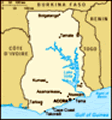Advertisement
Published: March 9th 2024
Firstly, can I offer some background and detail for those with only a superficial knowledge of this key element of West Africa’s history. It helps to explain why slavery is still an undercurrent of most aspects of life today in this region.
The Transatlantic slave trade involved the transportation by slave traders of
enslaved African people, mainly to the
Americas. The outfitted European
slave ships of the slave trade regularly used the
triangular trade route, and existed from the 16th to the 19th centuries. The vast majority of those who were transported were from West Africa, who had been sold by
West African slave traders mainly to Portuguese, British, Spanish, Dutch, and French slave traders. European slave traders gathered and imprisoned the enslaved at forts on the African coast and then brought them to the Americas. The colonial South Atlantic and Caribbean economies were particularly dependent on labour for the production of
sugarcane and other commodities, including coffee, tobacco, cocoa, and cotton
plantations, gold and silver mines, rice fields, the construction industry, cutting timber for ships, as skilled labour, and as domestic servants.
Current estimates are that about 12 million Africans were shipped across the Atlantic over a span of 400 years. The number purchased by
the traders was considerably higher, as the passage had a high death rate, with between 1.2 and 2.4 million dying during the voyage, and millions more in
seasoning camps in the Caribbean after arrival in the New World. Near the beginning of the 19th century, various governments acted to ban the trade, although illegal smuggling still occurred. It was generally thought that the transatlantic slave trade ended in 1867, but evidence was later found of voyages until 1873. In the early 21st century, several governments issued apologies for the transatlantic slave trade.
Over the course of two centuries, more than one million enslaved Africans were deported from the town of Ouidah on the south coast of
Benin. They were blindfolded and marched in chains a few miles from the town’s slave market to the nearby port, where they would board ships to unknown destinations, the majority of them never to return. Small rowboats would take them out to the larger ships, and some would jump overboard in the rough water rather than face the uncertainty of the voyage or the life ahead. For most, the beach at Ouidah was the last sight of Africa they would ever see.
A
number of memorials have been set up, but the largest and most impactful of these stands at the end of the Slave Route. This is called the Door of No Return, a memorial arch, or gateway, built in 1995. Both sides of the arch are covered in images of enslaved men and women. The main mural on the inland-facing side depicts enchained men walking toward the sea, a ship waiting for them in the distance. On the sea-facing side, the mural shows them walking away from their homeland, a single tree in the distance representing the land that most of them would never see again.
Of interest, just nearby this memorial arch, we noted some heavy construction work being carried out by the Chinese. It’s reassuring to know that President Xi has such an interest in West African history!
After our visit to the Ashanti region around Kumasi, we then drove back to the coast and our final destination before the capital, Accra, was a little fishing town called Elmina. This town lies on a narrow finger of land between the Atlantic Ocean and Benya Lagoon. Here, the architecture was a mix of colonial remnants and elderly shrines,
but the main focus of the town seemed to be on the extensive fish markets next to the harbour. As well as being a really attractive little town in its own right, with hundreds of colourful fishing boats, called pirogues, moored in the delta and a scurry of activity around these, the town is dominated by the whitewashed St George’s Castle, the oldest European building in Africa. The castle dates back to C15 and ‘changed hands’ from that time from the Portuguese to the Dutch to the British. But more importantly, this was one of a number of places where slaves were held awaiting transportation to the new world, and the cells in which they were held still remain as a poignant reminder of the harsh conditions in which they were subjected. We took an organised tour through the castle which took us to the grim dungeons, punishment cells, and the turret room where the British imprisoned the Ashanti king, Prempeh I, for four years. So once again, we visited an attractive little town that has a running undercurrent of the history of slavery.
My next and final blog for this region will outline some of the minor visits
and give some of my overall reflections on my tour of Togo, Benin and Ghana.
Advertisement
Tot: 0.098s; Tpl: 0.014s; cc: 11; qc: 24; dbt: 0.0564s; 1; m:domysql w:travelblog (10.17.0.13); sld: 1;
; mem: 1.1mb


















Salesforce Masters
non-member comment
Salesforce course in hyderabad
This is an awesome post. Really very informative and creative content. Thanks for sharing! salesforcemasters.in/